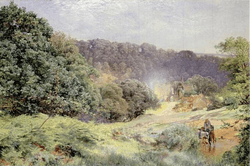Reginald of Durham
Reginald of Durham (died c. 1190) was a Benedictine monk and hagiologist, a member of the Durham Priory and associated with the Coldingham Priory.[1]

Reginald of Durham, Vita et Miracula Sancti Godrici
The details of his life are uncertain, but he was "apparently of English descent" and had joined the monks at Durham by around 1153. He was active in the 1160s and 1170s, spending time in Finchale with the hermit and saint Godric, and writing the works for which he is now known. It is thought that the time spent in Coldingham came later, after 1188, though again this is not certain – an alternative explanation for the association with Coldingham is that it was his birthplace, though this is considered less likely.[2]
Two lengthy works on saints are attributed to Reginald. The first is an account of the life of Godric—including his taming influence on the snakes of Finchale that eventually nestled by his fireside—and the miracles that followed the saint's death. The second is a collection of 129 posthumous miracles attributed to the 7th-century saint Cuthbert, such as those associated with St Cuthbert's Well. The stated purpose of his libellus or "little book", kept near Cuthbert's shrine in Durham Cathedral, was to honour Cuthbert; it was also in the interests of the monastic community in Durham to maintain the cult of Cuthbert when that of the 12th-century saint Thomas was growing in Canterbury.[3] A much shorter work concerned another 7th-century saint, Oswald, a martyred King of Northumbria. All three of these works included contributions by Aelred of Rievaulx, who encouraged and aided Reginald's work.[1]
A fourth work may have been the basis of a sermon about St Ebba (615–683), however the sermon itself is not in the style associated with Reginald. According to Tudor, that style could "degenerate into almost incomprehensible turgidity", but his desire for detail and capacity for close observation made him capable of "extremely vivid evocation of contemporary conditions".[1]
Notes
- Victoria Tudor, Coldingham, Reginald of (d. c.1190), Oxford Dictionary of National Biography, Oxford University Press, 2004, accessed 6 February 2012
- The account here follows that given in the entry on Reginald of Coldingham by Tudor (2004) in the Oxford Dictionary of National Biography, the earlier entry in the Dictionary of National Biography having been written by Mary Bateson and published in 1896 (see Reginald of Coldingham).
- Tudor 1989
References
- Reginald of Durham, Reginaldi Monachi Dunelmensis Libellus de Admirandis Beati Cuthberti Virtutibus Quae Novellis Patratae Sunt Temporibus
- Smith, Beverley Ballin; Taylor, Simon; Williams, Gareth, eds. (2007), West over sea: studies in Scandinavian sea-borne expansion and settlement before 1300 : a festschrift in honour of Dr. Barbara E. Crawford, Northern world, 31, Brill, pp. 195–226, ISBN 90-04-15893-6, "A Norwegian in Durham: Anatomy of a Miracle in Reginald of Durham's Libellus de admirandis beati Cuthberti" by H. Antonsson, S. Crumplin and A. Conti (for a summary of the three miracles)
- Tudor, Victoria (1981), Reginald of Durham and Saint Godric of Finchale: learning and religion on a personal level, Studies in Church History, 17, pp. 37–48
- Tudor, Victoria (1989), "The Cult of St Cuthbert in the Twelfth Century: The Evidence of Reginald of Durham", in Bonner, Gerald; Rollason, David W.; Stancliffe, Clare (eds.), St. Cuthbert, his cult and his community to AD 1200, The Boydell Press, pp. 447–468, ISBN 0-85115-510-3 (for a discussion of the role of Reginald of Durham's Libellus in the cult of St Cuthbert)
- Ridyard, Susan J. (2001), Functions of a Twelfth-Century Recluse Revisited: The Case of Godric of Finchale, Belief and culture in the Middle Ages: studies presented to Henry Mayr-Harting, Oxford University Press, pp. 236–250
External links
| Wikisource has original text related to this article: |
- Life of Saint Godric – excerpts